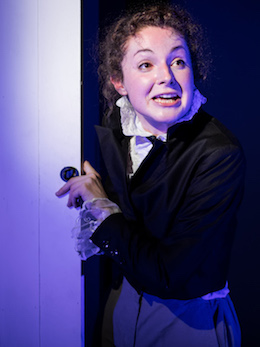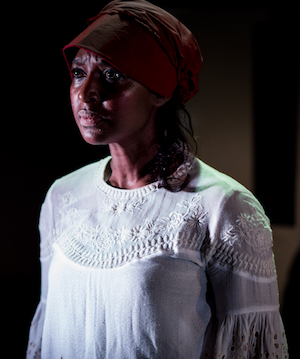Square Rounds, Finborough Theatre review - the science behind warfare, told in verse | reviews, news & interviews
Square Rounds, Finborough Theatre review - the science behind warfare, told in verse
Square Rounds, Finborough Theatre review - the science behind warfare, told in verse
Didactic theatre piece stronger on facts than drama

The title of Tony Harrison's teacherly entertainment – it can't be called a play – refers to the square bullets invented by James Puckle to kill Muslims in the 18th century. This shocking morsel of information is provided by the brothers Hiram and Hudson Maxim, inventors respectively of the machine gun and smokeless gunpowder, who are two of the characters in Square Rounds.
That apparent oxymoron might also imply attempts to square impossible circles, to the irony of scientific curiosity so frequently leading simultaneously to beneficial and destructive ends. Hiram Maxim (played energetically by Letty Thomas) invented an inhaler for asthmatics as well as a mousetrap, a sprinkler system and various pumps and motors besides the gun which takes his name. Then there is the irony of the scientists determined to believe that their creative killing methods are for the ultimate good of mankind.
 Square Rounds was first presented in 1992 on the Olivier stage as an informative extravaganza, all-singing, all-dancing, full of colour and magic, revelling in the resources of the National Theatre. The Finborough version, produced by Proud Haddock in association with Neil McPherson, is its first revival and is, of necessity, small-scale. The cast of 27 actors and musicians is replaced by only six, the razzamatazz mostly missing, but the essentials of the piece are there. There is even some simple magic – handkerchiefs change colour, candles disappear – and the young actors, all clearly having a ball, occasionally burst into song. More often they are handling rhythmic verse, gleefully pointing up insistent rhymes. The original cast was overwhelmingly female; now it is entirely so.
Square Rounds was first presented in 1992 on the Olivier stage as an informative extravaganza, all-singing, all-dancing, full of colour and magic, revelling in the resources of the National Theatre. The Finborough version, produced by Proud Haddock in association with Neil McPherson, is its first revival and is, of necessity, small-scale. The cast of 27 actors and musicians is replaced by only six, the razzamatazz mostly missing, but the essentials of the piece are there. There is even some simple magic – handkerchiefs change colour, candles disappear – and the young actors, all clearly having a ball, occasionally burst into song. More often they are handling rhythmic verse, gleefully pointing up insistent rhymes. The original cast was overwhelmingly female; now it is entirely so.
The premise is that "munitionettes", stuffing canisters with TNT in the First World War, morph into historical figures to tell the story of their place in scientific warfare. The most significant of these, so horribly up-to-date from Syria to Salisbury, is Fritz Haber's chemical weapon, chlorine gas. It is extra resonant in the anniversary year of the end of the Great War: in a graphic moment the cast simply file across the stage, blindfolded, as in a Paul Nash painting. And, in a further irony, the gas will later be used by Hitler to kill Haber's fellow Jews. But Haber's other important invention was fertiliser, a beneficial use of chemicals which still helps to feed the world. Philippa Quinn plays him with the right mixture of sincerity and arrogance, and it is her scene with a passionate Gracie Goldman as Clara (pictured below, right), Haber's suicidal wife – herself a brilliant chemist – which comes nearest to true drama. Meaningful interaction between characters is otherwise rare. Clara sees that gas is not a more benign weapon than guns and would not shorten the suffering of the war, but having failed to persuade her husband, she shoots herself.
 The set has a toilet cubicle-cum-magic box at its centre. The proper ecological use of human waste is again a live topic, as it was in 1992 and 1850. Eva Feiler as Justus von Liebig (pictured above, left), founder of organic chemistry and proponent of nitrogen (available from excrement) in fertiliser, is fervent and funny, capturing the verse rhythm conversationally and matching it with a winning physicality.
The set has a toilet cubicle-cum-magic box at its centre. The proper ecological use of human waste is again a live topic, as it was in 1992 and 1850. Eva Feiler as Justus von Liebig (pictured above, left), founder of organic chemistry and proponent of nitrogen (available from excrement) in fertiliser, is fervent and funny, capturing the verse rhythm conversationally and matching it with a winning physicality.
Director Jimmy Walters, whose production of Harrison's earlier more exuberant piece, The Trackers of Oxyrhynchus, sold out here a couple of years ago, oversees some neat ensemble work. And Depi Gorgogianni, movement director, ensures some deft circling around the black-and-white cubes of Daisy Blower's flexible set.
The bones of several fascinating plays lie buried here, waiting to be clothed in Harrison's robust, rhythmic, refulgent language. But for all its quirkiness and ambition, Square Rounds remains a superior example of theatre-in-education, albeit here delivered in an intimate seminar room rather than a lecture hall.
rating
Explore topics
Share this article
The future of Arts Journalism
You can stop theartsdesk.com closing!
We urgently need financing to survive. Our fundraising drive has thus far raised £49,000 but we need to reach £100,000 or we will be forced to close. Please contribute here: https://gofund.me/c3f6033d
And if you can forward this information to anyone who might assist, we’d be grateful.

Subscribe to theartsdesk.com
Thank you for continuing to read our work on theartsdesk.com. For unlimited access to every article in its entirety, including our archive of more than 15,000 pieces, we're asking for £5 per month or £40 per year. We feel it's a very good deal, and hope you do too.
To take a subscription now simply click here.
And if you're looking for that extra gift for a friend or family member, why not treat them to a theartsdesk.com gift subscription?
more Theatre
 Intimate Apparel, Donmar Warehouse review - stirring story of Black survival in 1905 New York
An early Lynn Nottage work gets a superb cast and production
Intimate Apparel, Donmar Warehouse review - stirring story of Black survival in 1905 New York
An early Lynn Nottage work gets a superb cast and production
 Hercules, Theatre Royal Drury Lane review - new Disney stage musical is no 'Lion King'
Big West End crowdpleaser lacks punch and poignancy with join-the-dots plotting and cookie-cutter characters
Hercules, Theatre Royal Drury Lane review - new Disney stage musical is no 'Lion King'
Big West End crowdpleaser lacks punch and poignancy with join-the-dots plotting and cookie-cutter characters
 Showmanism, Hampstead Theatre review - lip-synced investigation of words, theatricality and performance
Technically accomplished production with Dickie Beau never settles into a coherent whole
Showmanism, Hampstead Theatre review - lip-synced investigation of words, theatricality and performance
Technically accomplished production with Dickie Beau never settles into a coherent whole
 4.48 Psychosis, Royal Court review - powerful but déjà vu
Sarah Kane’s groundbreaking play gets a nostalgic anniversary reboot
4.48 Psychosis, Royal Court review - powerful but déjà vu
Sarah Kane’s groundbreaking play gets a nostalgic anniversary reboot
 Joyceana around Bloomsday, Dublin review - flawless adaptations of great dramatic writing
Chapters and scenes from 'Ulysses', 'Dubliners' and a children’s story vividly done
Joyceana around Bloomsday, Dublin review - flawless adaptations of great dramatic writing
Chapters and scenes from 'Ulysses', 'Dubliners' and a children’s story vividly done
 Stereophonic, Duke of York's Theatre review - rich slice of creative life delivered by a 1970s rock band
David Adjmi's clever and compelling hit play gets a crack London cast
Stereophonic, Duke of York's Theatre review - rich slice of creative life delivered by a 1970s rock band
David Adjmi's clever and compelling hit play gets a crack London cast
 North by Northwest, Alexandra Palace review - Hitchcock adaptation fails to fly
Emma Rice's storytelling at fault in misconceived production
North by Northwest, Alexandra Palace review - Hitchcock adaptation fails to fly
Emma Rice's storytelling at fault in misconceived production
 Hamlet Hail to the Thief, RSC, Stratford review - Radiohead mark the Bard's card
An innovative take on a familiar play succeeds far more often than it fails
Hamlet Hail to the Thief, RSC, Stratford review - Radiohead mark the Bard's card
An innovative take on a familiar play succeeds far more often than it fails
 The King of Pangea, King's Head Theatre review - grief and hope, but no connection
Heart and soul proves insufficient in world premiere of therapeutic show
The King of Pangea, King's Head Theatre review - grief and hope, but no connection
Heart and soul proves insufficient in world premiere of therapeutic show
 A Midsummer Night's Dream, Bridge Theatre review - Nick Hytner's hit gender-bender returns refreshed
This Dream is a great night out, especially for Shakespeare first-timers
A Midsummer Night's Dream, Bridge Theatre review - Nick Hytner's hit gender-bender returns refreshed
This Dream is a great night out, especially for Shakespeare first-timers
 Miss Myrtle’s Garden, Bush Theatre review - flowering talent, but needs weeding
New play about loss, love, grief and gardening is humane, but flawed
Miss Myrtle’s Garden, Bush Theatre review - flowering talent, but needs weeding
New play about loss, love, grief and gardening is humane, but flawed
 Fiddler on the Roof, Barbican review - lean, muscular delivery ensures that every emotion rings true
This transfer from Regent's Park Open Air Theatre sustains its magic
Fiddler on the Roof, Barbican review - lean, muscular delivery ensures that every emotion rings true
This transfer from Regent's Park Open Air Theatre sustains its magic
